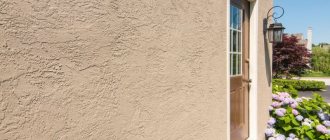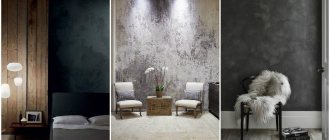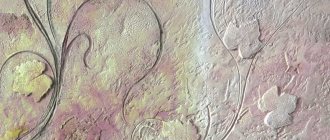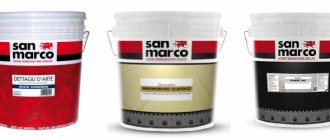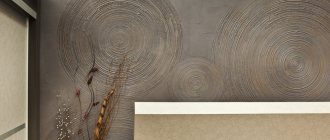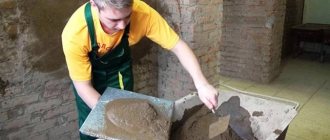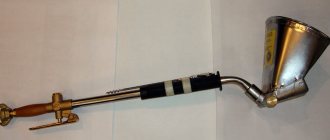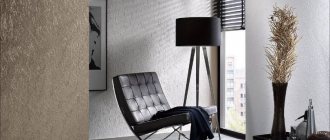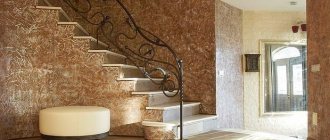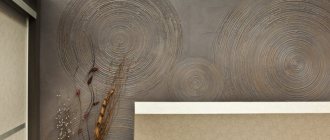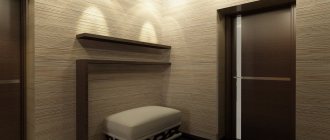Features of textured plaster
The composition of textured plaster, along with the binder, also includes other components that make its consistency softer - pieces of granite or other minerals.
Using this fine-grained mixture, it is easy to create a colorful texture on the smooth surface of the ceiling and walls. If necessary, it can be used as putty.
Plasters of this type are used for decoration. A thin layer of the composition is applied to the surface of the walls and the desired pattern or relief pattern is created on it.
Their main properties:
- plastic;
- viscosity;
- strength;
- no shrinkage after applying the layer and drying it;
- immunity to high temperatures;
- ease of application on any surface, even with imperfections.
You can make textured plaster yourself. To do this, add stone chips or wood fibers to the usual composition and tint the resulting mass.
This finishing material has a number of advantages over others:
- Textured plasters can be considered a universal way to decorate walls. The original coating can be selected for any interior style.
- Patterns and designs to create texture are done quickly and effortlessly. It is enough to move the roller one or several times.
- The composition includes components that are resistant to ultraviolet rays. The initial color saturation does not change over time.
- You can add different paints to ready-made mixtures and change their shades and tone.
- Characteristic enhancement of the thermal insulation properties of the base.
- Environmentally friendly composition. It does not release harmful substances into the surrounding space. Suitable not only for decorating the exteriors of buildings, but also interiors.
- To increase the aesthetic expressiveness of textured plaster, mother-of-pearl is added to it.
Textured or relief plaster does not smell. It also does not absorb foreign odors. When working with this material, you should strictly follow the rules for applying plasters of any kind to walls. Otherwise, it may begin to gradually collapse. Or vice versa, it will be very difficult to remove it, if necessary.
Advantages and disadvantages
Let's consider the positive qualities of the finishing material:
- textured coating looks good and contributes to better interior design;
- the surface relief can be designed in different styles, creating beautiful patterns by choosing a special technique for moving the tool;
- the material is durable, the surface retains its original appearance for a very long time;
- the mixtures are resistant to ultraviolet radiation, so they do not gradually fade in the sun, maintaining their original attractiveness;
- the finishing coating improves the thermal insulation qualities of the base;
- mixtures for interior decoration do not contain aggressive chemical components, therefore they are considered environmentally friendly for people;
- The color of the finish can be changed as desired by adding dyes to the solution.
On a note!
The finished mixture can be supplemented with other components to create original visual effects.
The disadvantages include:
- the coating does not withstand strong impacts, gets scratched, chips;
- a textured surface is more difficult to clean from dust;
- for high-quality materials you will have to pay an impressive amount;
- in order for the surface to look holistic, the mixture is applied without delay or interruption;
- surface defects are very difficult to correct.
If the application technology is violated, cracks may appear on the surface. The material often peels off and swells. Therefore, you need to choose a mixture suitable for the specific type of base and follow the manufacturers’ recommendations when performing finishing work.
Types of textured plasters
There are several types of popular plasters. They are easy to make yourself. This does not require any special professional skills. A solid but breathable compound applied to a flat surface can resemble wood, leather, natural stone or fabric.
Bark beetle
The plaster called “Bark Beetle” resembles a wooden surface eaten away by bugs. The color, size and volume of the fractions differ.
The walls of a building or room can be decorated either completely or fragmentarily. “Bark beetle” is a finishing coating that is applied to stone, brick, cement, plasterboard or wood surfaces that are strong enough to support the weight of the plaster without deformation. Bright and expressive effects can be achieved using mixtures with inclusions of different sizes.
In this case, their properties will be identical. This type of plaster is also successfully used for exterior work - finishing fences, walls, garden gazebos.
They decorate bathrooms and swimming pools. To prevent exposure to moisture, the finished surface is coated with a special protective varnish.
Under the brick
One of the most stylish and interesting types of textured plaster is considered to be an imitation of a brick wall. Smooth, unsloping walls are suitable for decoration. If there are flaws or tilt, the defects are first eliminated. The cracks or individual recesses are sealed with mortar. The cemented surface is primed. If the walls are smooth, there is no need to use cement mortar. They are immediately treated with a primer with the addition of glue. When creating a brick finish, you should take into account the dimensions of real bricks, which are not only rectangular, but also square.
Advantages of textured material
Textured mixtures are used for plastering any premises. They are often used to focus attention on certain architectural elements - columns, niches, false fireplaces, etc.
Main advantages:
- Moisture resistance - the compositions can be used even for finishing bathrooms and other rooms with high humidity levels.
- Increased strength – ensures the durability of the decorative coating and its resistance to mechanical stress.
- Plasticity of the finished plaster layer - the material is able to slightly stretch during operation without the formation of cracks, which makes it resistant to shrinkage deformations.
- Practicality - the finished coating does not require special care; if necessary, it can even be washed with water.
Everything can be learned by comparison: ordinary wallpaper provided the owners with a whole set of undeniable advantages, the main ones of which, perhaps, are the ease of application and versatility of use.
What about the obvious advantages of textured plaster?
- resistance to any mechanical stress;
- excellent vapor permeability;
- maintaining performance at any temperature;
- high level of fire resistance;
- not afraid of ultraviolet rays;
- variety of surface relief;
- wide selection of color options;
- no toxic substances in the composition;
- good heat and sound insulation;
- basic installation and dismantling.
As you can see, textured plaster has more than enough advantages in terms of expressive wall design - in the photo you can only see how perfectly this or that texture fits into the interior. If you go from the other side and try to “dig out” the negative, then the first thing that comes to mind is the relatively short service life.
Regarding other, more sustainable finishing materials. Otherwise, we have before us a case where even with the greatest desire to come up with a minus out of the blue, nothing happens.
Color range of textured plasters
To create plaster mixtures, natural and natural paints are most often used. It is best to imitate wood using yellow or ocher shades, such as straw, golden oak, or pear. But brown colors are also suitable - nut, light brown with a hint of ocher, coffee, cream.
White textured plaster is most often used to decorate public buildings and offices. Its neutral shades allow you to add solemnity to any room with a large area.
This finish is also suitable for small rooms and bedrooms. Makes them lighter, creates the illusion of exceptional purity and freshness. White walls fit perfectly into many interiors and suit any color palette. They prevail in Scandinavian style and in most modern ones.
Gray plaster with a concrete or metal effect is chosen by lovers of high-tech, industrial, techno, minimalism or loft styles.
Mother-of-pearl options with a beautiful patterned texture will delight owners of interiors in oriental styles - Arabic, Indian, Moroccan and Asian. The walls look especially original in combination with mirrors and decor with mother-of-pearl inclusions and silver metal.
Combination of decorative plaster with finishing
If you need to determine what types of finishes decorative plaster can be combined with in the bedroom, then you need to pay attention to the texture, color and pattern of the surface. Finishing refers to different coverings of walls, their projections, columns, niches, as well as details of the decoration of the ceiling, window or interior arched openings.
If the room is being furnished in a loft style, then a structural mixture or art-concrete plaster will work well with brick or stone masonry.
For living rooms in a classic, English or Italian style, a combination of smooth surfaces of ordinary plaster, painted in the same tone, with marble decorative plaster would be ideal.
Any authentic or ethnic style will look harmonious if you combine decorative bark beetle plaster with wooden surfaces - ceiling beams, curtain rods, shelves, furniture.
Venetian plaster looks accentuated with a plain ceiling (painted or stretched). Artistic parquet or beautiful tiles are ideal for this exquisite wall covering.
Marseille wax is most suitable for interiors in Provence, Baroque, and Country styles. It completely replaces the wallpaper functions. This type of wall decoration will harmonize wonderfully with gypsum stucco molding and elegant forging elements.
Mosaic plaster, granite (or any composite finishing material), stone, brickwork is an ideal solution for combining two different finishing methods. The granite slab also has inclusions in the mosaic, so they go well together.
Sea Breeze plaster has a palette of over 45 color options.
Among them, the most popular ones are sandy, golden, sea green, pearl, light and dark mother-of-pearl, white gold, silver, chameleon. This allows the material to be used in tandem with decorative wallpaper, photo wallpaper, airbrushing and other types of plasters.
Compound
Usually, mica, gypsum, sand, ground brick particles, and wood fibers are added as inclusions to plaster mixtures.
Textured acrylic plasters also contain acrylic resins. This allows you to give the mixture the necessary plasticity and increases the possibility of setting with bases of all types.
The use of a spectrum of acrylic paints makes acrylic-based plasters the leaders. This finish is durable and durable. But there are also disadvantages. First of all, the flammability of the mixture and the ability to attract dust.
Preparation work
The most important thing when using textured plaster is to see the desired effect and implement it correctly. If you have an idea of the type of plane you want and its design, then you can begin to select the materials and tools that may be required. It’s best to consult with a decorator or look at more photographs with ready-made coatings to choose the best option. It is necessary to take into account that textured plaster is, in any case, more prone to retaining dust and moisture, so it is better to use smoother reliefs in the kitchen area. For the same reason, due to high humidity, the surface in the bath should be well and firmly protected with varnishes or polymers.
By default, any textured wall plaster must be done with your own hands on a prepared surface. The wall is carefully leveled and primed in advance. It is better to choose a primer mixture that has good penetration and allows the wall to dry well after use. Certain types of plasters make it possible to ignore small wall unevenness, but large differences in levels or unevenness should be removed in advance.
How to apply textured plaster
Home comfort and cleanliness often depend on the right choice of materials. Decorative plaster is considered one of the most interesting design options for modern apartments and building facades. It can be applied to walls and ceilings either by hand or using mechanisms, for example, a plastering station. A large selection of textures and shades allows you to use the compositions in new design projects or complement the design of walls and ceilings in previously created interiors.
Before starting work on applying textured plaster to any surface, you need to clean it of any remaining wallpaper, debris or dust. And then do the following:
- Carefully prime the wall.
- Choose a relief based on the capabilities and characteristics of the room. It can be a rock, wood, natural stone, orange peel, bark beetle and a number of others.
- Evenly distribute the contents of the package or container over the surface using a spatula.
- Adjust the resulting patterns or texture with a brush or sponge, and smooth out the resulting seams.
- To give the texture greater relief, you can use not only construction tools, but also improvised means: flat paint brushes, a notched trowel, a relief roller, crumpled stiff paper or whatman paper.
Where is it used?
The wide range of applications of decorative textured plaster is due to the fact that it has excellent adhesion to a wide variety of surfaces.
It turns out that with the help of decorative plaster they not only complement the interiors of houses and apartments, it is also used as a full-fledged finishing material for facades and a wide variety of external walls of buildings.
In interior design, textured plaster can be used to complement the walls and ceilings of a bedroom, living room, hall, hallway, kitchen and even bathroom (if we are talking about waterproof compounds).
Many experts prefer textured plaster as a finishing material in the hallway and hallway, since these are precisely the rooms where the walls often get dirty and worn out.
On a textured surface, any imperfections will be completely invisible thanks to such an unusual coating.
Since textured plaster is very simple and unpretentious to maintain, and many of its types are not afraid of moisture, it can easily be used to cover surfaces in the bathroom and kitchen.
Basically, the scope of application of plaster in the interior of a house is limited only by imagination, so do not be afraid to experiment and bring to life the most unusual and daring ideas.
Application in the interior
Decorative wall decoration in the form of textured plaster allows you to emphasize the advantages of various interiors. The presence of Bark Beetle plaster in an apartment or office enhances its modern look and adds practicality to the design.
The matte surface with long grooves applied to it is very similar to wood. Beige, blue or pink shades are chosen for bedrooms, and more saturated colors for hallways.
Kitchen walls coated with a dark composition will look gloomy. Therefore, they plaster with textured mixtures with delicate shades or combine colors.
Textures similar to drops of water, sea foam or snake skin look impressive.
Last stage and decoration
When the texture has been given to the plaster, measures must be taken to protect it and subsequently design it. First, make a primer mixture. Then you can do one or a couple of layers of paint.
To make plaster for decorative work look better, you can highlight the relief using paints. It is necessary to very carefully paint every centimeter of the surface with paint of a darker color, using a long-haired roller or brush. After the first layer has dried, use a short-haired roller or just an ideal rubber one to apply brighter paint to the tops of the protruding parts of the texture.
If painting is unnecessary or colored plaster with pigments is used, every centimeter of the surface must still be covered with a layer of protection. In this version, colorless varnish is used.
How to make textured plaster yourself
The cost of the decorative composition depends on the brand of the incoming components. Buying ready-made textured plaster from well-known manufacturing companies can be expensive. But, if you make the mixture with your own hands from putty, then decorating the walls with it will be much more profitable than with wallpaper. The mixture, made independently, is suitable for application with a roller or using a stencil:
- The base is gypsum or chalk powder (6 kg 500 g).
- 2 kg of CMC glue solution (5%). Bred in accordance with the recommendations src=”https://balkon4life.ru/wp-content/uploads/2020/04/5e284af49f35998f484a3455.jpg” class=”aligncenter” width=”480″ height=”600″[/img]
- 800 g PVA glue.
- 1 bar of laundry soap (72%) serves as a plasticizer. Grind on a grater and dilute with water to the consistency of thick sour cream or gel.
It is better to mix the ingredients with a construction mixer. First, liquid components, and then gradually add powdered ones. Leave for a while and then mix more intensively. This composition has a long drying period, which allows it to be used even by inexperienced beginners.
Adding texture
Depending on the desired result and the tool used, the application method may differ.
To add texture you can use:
- Rollers . For all this, just use a hair roller. After its application, a finished surface with a unique image will come out. Alternatively, you can use a spatula on top of the result, slightly smoothing the plaster. Another option is to use rollers with an image or pattern printed on them. In this embodiment, the roller is applied once along the entire length or height of the wall to create an image, or in multidirectional strokes to make a fragmented pattern. If you apply the plaster directly with a roller, the material consumption will be significantly reduced.
- Ready stamps . This type of tool actually resembles a large stamp with a design or pattern inscribed on the surface to work with. By applying it to the wall and pressing, the pattern is transferred to the plaster. Throughout the work, you need to constantly clean the stamp from adhering plaster and wet it with water. A set with a stamp often also includes a soft version made from a sheet of rubber for finishing the image in narrow areas of the wall
- Spatula, trowel, brush . Using a regular spatula, facing with textured plaster will turn the wall into a real painter's canvas. The most common option is to repeat the texture of unbridled stone, when using spatula movements in discordant patterns give a free shape to the plane. You can also, by slightly deepening the spatula into the plaster, depict the desired pattern in strips with a smooth surface. The same goes for a toothed trowel or brush. You will need to create images or patterns yourself, but the effect will be as unique as possible and the way you want.
Price
The cost of the decorative composition depends on the brand of the incoming components. Buying ready-made textured plaster from well-known manufacturers can be expensive. The price for 1 m2 of treated surface depends on the professionalism of the specialist, the quality and speed of work. If you do everything yourself, then renovations in a house or apartment can be done without spending a lot of money and time.
But you can also buy a ready-made mixture. VGT textured plaster is easy to apply. It is highly viscous and coarsely dispersed. It is distinguished by its versatility, as it can be used to decorate various coatings. In addition to elasticity, the composition is moisture resistant. Suitable for indoor and outdoor use. Preliminary preparation of surfaces is not necessary. All defects are smoothed out using this mixture, which is made on the basis of acrylic binders and marble chips. One container holds 18 kg. 2 kg of mixture is required per 1 m2 (when applied in one layer). This means that one container is enough to treat a wall with an area of 9 m2.
Subscribe
Basic point of work
The application of any textured plaster begins with the distribution of the solution over the entire wall or part of it in an important layer. To do this, use a smoothing iron. There is no need for special precision in distribution; the most important thing is uniformity of thickness with a small error. The required layer thickness is selected from the instructions for the solution and according to the type of result required. Taking into account the height of the image, a minimum of 1.5 mm of mortar thickness should be left underneath.
In order to understand without outside help how to apply textured plaster, it is best to experiment on a small section of the wall or on a piece of plaster. In the end, you can very quickly select the desired layer thickness and image application option.
Ready-made compositions are made specifically for slow drying in order to give the master more time to form the image and distribute it evenly. When using a simple sand-cement or cement-gypsum mortar, it is better to clearly formulate your actions in advance and divide each centimeter of the surface into sections that will be carried out gradually.
Spatula and trowel
These tools can be used to imitate stones of different types, lay Venetian stones, and highlight the texture.
- Use a spatula to take a portion of plaster, apply it to a trowel and distribute it over the wall in circular and multidirectional movements.
- The trimming technique is worthy of attention, when a trowel or spatula is pressed tightly onto the applied mortar and quickly removed, forming a kind of fur coat.
This effect can be used in individual areas as small fragments.
Required tools and materials
For finishing work you will need:
- textured plaster;
- trowel;
- rubber and metal spatulas of different sizes;
- grater;
- rule;
- plumb and level;
- masking tape or tape, plastic film;
- brushes, rollers and paint;
- various tools for adding texture to plaster.
For the preparatory stage you need the following:
- primer;
- paint brush;
- sandpaper or sander;
- putty and spatula.
Preparing walls for finishing requires special tools
Varieties
Textured plaster can be made from any composition to which a filler with certain properties is added. Therefore, there are many varieties of material on sale.
They are distinguished by two basic characteristics:
- by type of binder (this is a base that can be used as an independent plaster composition);
- by type of filler (these are materials that give the coating a relief with different decorative properties).
Based on the type of binding material, there are different types of textured plaster, which should be considered more carefully.
Acrylic
This is a mixture made from acrylic resin with additional components. The composition is elastic and tolerates temperature fluctuations, vibration, and wall shrinkage. It is sold in finished form, which facilitates and speeds up the work process (no need to mix the composition), but makes transportation and storage difficult.
Advantages of acrylic compositions:
- the coating dries quickly;
- can be used in damp rooms with frequent temperature changes;
- service life reaches 15 years;
- The coating can be washed without losing its appearance.
The disadvantages of acrylic compositions should be considered:
- ability to burn;
- do not tolerate exposure to solar ultraviolet radiation;
- low vapor permeability, requiring high-quality ventilation of the premises.
Acrylic textured plaster does not require subsequent painting. It can be given the desired shade in advance using a special pigment.
Mineral
This is a textured plaster created from natural components of mineral origin:
- cement;
- lime;
- clay;
- stone chips (granite, marble, etc.).
This material is commercially available in the form of a dry mixture, which must be mixed with water before application.
The advantages of mineral plaster are considered to be:
- low cost and ease of application;
- high vapor permeability, allowing finishing work both inside and outside the premises;
- Fire safety;
- strength, ability to easily withstand low temperatures and mechanical stress.
The disadvantages include:
- relatively short service life (up to 10 years);
- small selection of color options;
- low elasticity, which does not allow coating to be applied to unstable substrates;
- The surface can be painted only after the composition has completely dried.
Another disadvantage of the material is poor adhesion to some building materials. Before application, the wall must be properly primed and all defects - cracks and potholes - must be repaired.
Silicate
The basic component of the binder is liquid glass, which makes the coating the most durable and resistant among alternative options.
The advantages of the material include:
- elasticity;
- resistance to moisture;
- high coating strength;
- long service life (up to 20 years);
- high vapor permeability;
- Fire safety.
Flaws:
- sold ready-made, which makes loading, transportation and storage difficult;
- a small number of color shades of the material;
- the need to use a silicate primer to ensure adhesion to surfaces;
- the mixture dries quickly, which is both an advantage and a disadvantage, forcing you to work quickly and without pauses.
Silicate coatings are considered harmful to human health, therefore, textured plaster of this type is used only for exterior work.
Silicone
This is a group of materials made on the basis of silicone resins. They are distinguished by high elasticity, which allows finishing unstable walls that experience temperature changes, vibration loads, and moisture.
Silicone compounds are ideal for interior decoration. They contain antifungal additives, therefore, the appearance of mold on the walls is impossible.
Advantages of silicone textured plaster:
- high vapor permeability;
- coating strength;
- ease of care;
- moisture resistance;
- a wide selection of colors that maintain brightness regardless of service life;
- The material fits well on any base.
- The disadvantage of silicone plaster is considered to be its high price, which repels many users.
Sponge, cloth
To obtain an unusual visual effect on plaster, you can use a natural sponge. The texture of images when applied is arbitrary. To create an original design, the sponge can be cut and applied with the inside of the product.
Tamponation is done with light movements. The veins from the sponge come out to have unpredictable shapes and random sizes. To achieve a polychromatic effect, it is recommended to apply several multi-colored layers. When using a natural sponge, a light, spotted pattern is obtained on the surface.
You can also use a synthetic sponge, but the pattern will be smaller. The reason is that the artificial sponge has fine porosity and a round shape.
Applying decorative plaster to surfaces is a fascinating and creative process. The most important thing is to adhere to the technological description of all stages of plastering work.
